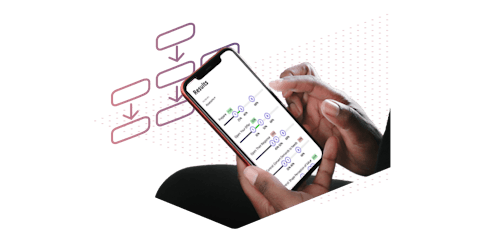The Benefits of Online Sales Training

Training a team of sales professionals is difficult. At a large organization, the team is often geographically distributed. Representatives are separated by hundreds of miles and different time zones. Even a small team of sales professionals can be difficult to train in unison because each professional is busy with their own quotas. Each is focused on their own pipeline that consists of sales at different stages. Schedules do not coalesce. For these reasons, selling organizations are increasingly focused on online sales training solutions.
A digital approach allows leaders to share the same training curriculum, at scale, with an entire team. Mobile optimization means that even sales professionals in the field can access and keep pace with training.
Here, we look at three reasons why online sales training drives results for both small and large organizations.
Online Sales Training Makes Measurement Easy
Research from Bain shows that metric-driven initiatives “increase profitability by as much as 25% over sustained periods” for sales organizations.
Despite these benefits, many selling organizations fail to generate and measure data. Often, the data sits in disparate systems.
Moreover, the available data represents different levels of accuracy, forcing the user to qualify the analytics first. Even after meeting these challenges, it is difficult to know what to measure. Online sales training solves this problem by providing real-time measurement capabilities.
The key is to simplify the process by segmenting measurement into what we call the E3 of learning metrics. These three sections are:
- Engagement
- Experience
- Effect
Engagement
A company can get an overview of engagement by looking at the percentage of the addressable population that is enrolled in training. Leaders can build on this measurement by examining activation, which is expressed as a percentage of enrollment. This figure shows how many participants are using the training platform. These two data points work together because a high engagement offers no value without a strong activation rate. Organizations can go even further by tracking the percentage of completion toward a milestone and pace of completion, the number of days between activities, and even the breakdown between those using a desktop vs. mobile device.
Experience
Leaders need to know the learner’s satisfaction with training not only today, but over months. This gauge of change over time is especially important as organizations embark on long-term training. Experiential measurements can include metrics like net promoter score, commitment to change, course rating, qualitative sentiment, and confidence. Each of these measurements provides timely info for managers who want to ensure that skills will survive into selling situations.
Effect
There are several ways to measure effect. This is an area in which the traditional Kirkpatrick training evaluation model is strong. The Kirkpatrick model evaluates training effectiveness across four levels: engagement, knowledge retention, behavior change, and business results. We often think of effect as the business impact. However, the Kirkpatrick model reminds us that we only reach business impact when we have a high degree of confidence in the other three levels of data.
Online Sales Training Drives Consistent Selling Practices
Sales professionals with a long tenure have an established approach while those who are new have a different style. As these disparate groups come together, an unevenness sets in.
This challenge intensifies as the organization’s solutions grow and change. As the products and services become more holistic and sophisticated, they often require new selling skills to fully articulate the breadth of their capabilities. Too often, the selling organization becomes a patchwork of inherited practices and bold new initiatives.
The solution: adopting a consistent selling methodology and a common sales language across the organization. Online sales training serves this need by distributing a scalable, universal curriculum across a dispersed group of sales professionals.
Consistency is critical as sales professionals increasingly sell as teams. They must coordinate around the same playbook. Coordination, however, becomes a challenge amid incongruent selling methods. Customers see this incongruence as a sign of disorganization and imbalance. An effective team selling engagement requires seamless transitions, concise messaging, and a consistent narrative flow. All of these elements demand a single core selling practice.
Finally, a consistent selling process enables new hires to reach time to productivity fast. Consistency offers a clarity of purpose that drives engagement, which is important because the most engaged employees “produce better business outcomes than other employees — across industry, company size, and nationality, and in good economic times and bad,” according to Gallup data collected from more than 195,600 US employees.
Online Sales Training Drives Sustainment
Online sales training drives sustainment because automated systems can periodically check and refresh the participants’ knowledge.
Consider research from Stanford behavior scientist B.J. Fogg who founded the Stanford Behavior Design Lab. His work in the field of behavior change has led to the Fogg Behavior Model (FBM), which posits that “behavior is a product of three factors: motivation, ability, and triggers.” That is, behavior change requires that the individual is sufficiently motivated, has the ability to execute the behavior, and has been triggered to behave accordingly. Additionally, the FBM asserts that all three of these factors must occur simultaneously to incite the new behavior. Online training can deliver these three factors.
The benefit of this structure is that it can be applied to large groups. As a result, teams embrace a shared perspective on behavior change. Online sales training can address each of these three factors in the following ways:
Motivate
Online sales training motivates participants because it represents the organization’s investment in the team’s skills and future. Motivation also emerges from the simple fact that improved selling skills will likely drive outcomes that are directly beneficial to the sales professionals engaged in training.
Execute
Online sales training equips professionals to execute skills by testing their knowledge with multiple choice answers to selling scenarios. This level of engagement represents the active learning that comes from the participant taking action and applying concepts as they are learned.

Richardson Accelerate™ Sales Performance Platform
Accelerate provides a digital learning experience that uses assessments, video, gamification, and bite-sized modules to build sales competencies.
Learn MoreTrigger
Online sales training prepares sales professionals to identify triggers in their conversations with customers. Practice scenarios illustrate how to determine where the customer resides in the buying journey. These triggers are important because they incite different selling behaviors that are appropriate at different times.
The scale and reach of a sales training initiative demands a structured approach that addresses the period before, during, and after training. Online sales training is uniquely suited to deliver on these needs by providing accurate measurement, consistent selling practices, and sustainment.

Brochure: Accelerate Sales Performance Platform
Learn more about Richardson Accelerate, the sales performance platform at the heart of our blended learning training solution.
DownloadGet industry insights and stay up to date, subscribe to our newsletter.
Joining our community gives you access to weekly thought leadership to help guide your planning for a training initiative, inform your sales strategy, and most importantly, improve your team's performance.






